Schuberth J2 helmet review
Published on: 02 April 2025
CLICK SCHUBERTH J2 HELMET TO SHOP WITH FREE UK NEXT DAY DELIVERY
Here at Motolegends we are not huge fans of open-face helmets. We haven't quite reached a position where we refuse to sell them, because some people know and accept the risks. But if you ever came to the shop we would usually try and dissuade you.
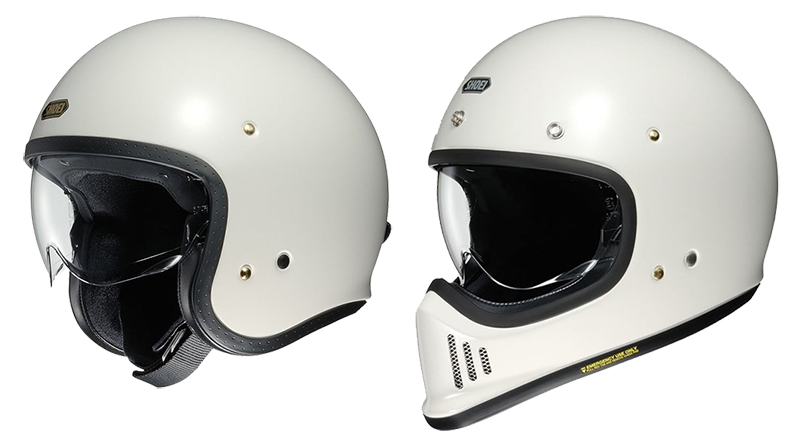
In recent years the only open-face helmet we have offered was the Shoei JO. In just about every respect it was the best open-face on the market, but we would always, as a point of principle, point people to the Ex-Zero which was in essence the JO with a moulded-in chin bar.
The reason for our ambivalence comes out of an accident I was involved in. I was hit from behind at low speed, and was thrown over the front of the bike. As ever when these things happen you don't remember much, and I walked away intact; nothing more than a few bruises. But what became clear was that I had slid down the road on my face. The whole front of my helmet, the chin and the visor in particular, were quite badly scraped and scuffed up.
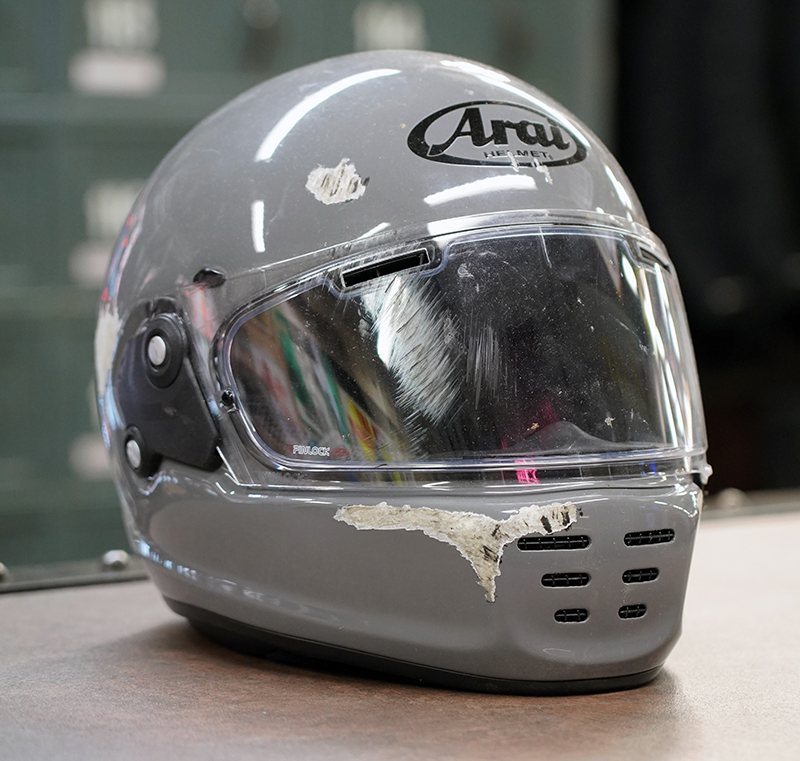
But what I realised was that had I been wearing an open-face helmet, I would have done a fair amount of damage. I don't know this, but I'm imagining plastic surgery, painful skin grafts, drinking through a straw, and so on.
We take our job here seriously. Yes, we know that motorcyclists can be concerned about how they look. And obviously staying warm, dry or cool on the bike is vital when it comes to riding safely. But at the end of the day we sell protective wear. And so we don't like to be involved with gear that doesn't perform its primary function. And there’s no item of protective wear that’s more important than a helmet.
As I've said, we don't usually point blank refuse to sell open-face helmets, but if you were new to biking, or a youngster, then sometimes we have done.
All of which means that getting excited about Schuberth's new J2 doesn't come easy!
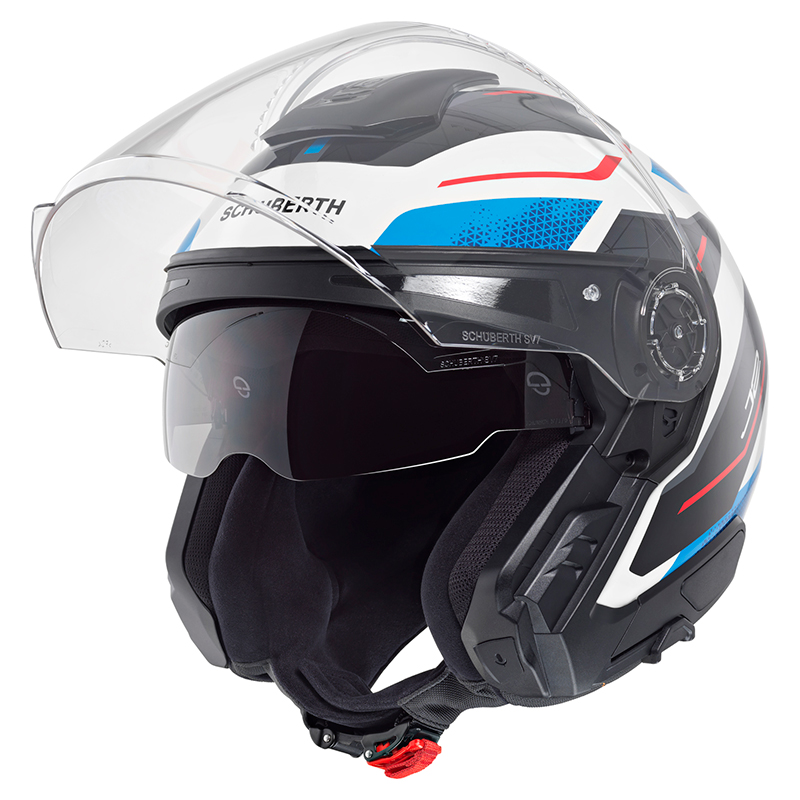
The Schuberth J2 helmet
Lots of manufacturers produce helmets like the J2. Basically, it’s an open-face helmet with a large, full-height, lift-up visor. I believe they are known in some circles as 'cruiser' helmets. And indeed they do seem popular with the Harley crowd.
I don't know whether Harley riders like them because they think they don't go fast enough to have an accident, or because an open-face helmet better conjures up that ‘Easy Rider’ look, but the best explanation I've been given is that if you're riding a cruiser with a big screen, a helmet that allows you to get better access to the oncoming air is very welcome. And that makes some sense.
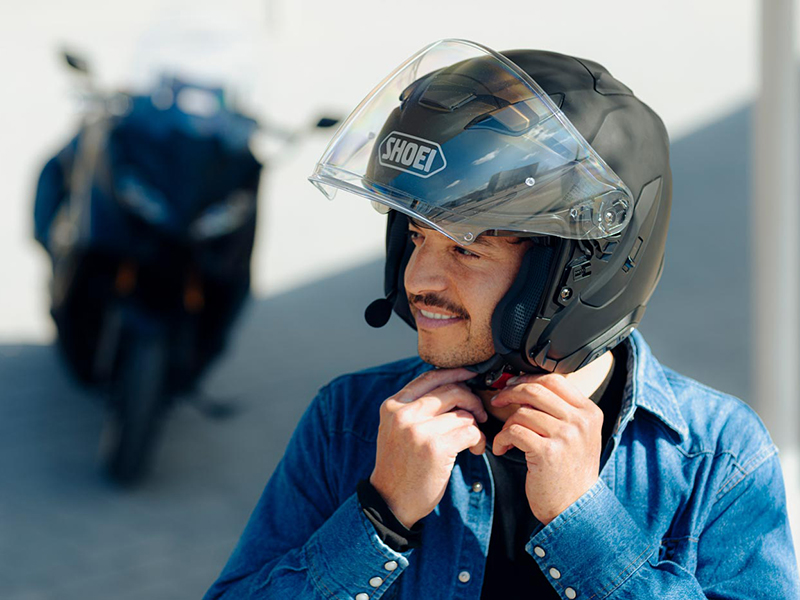
We already do the J-Cruise from Shoei, which is probably as good as one of these helmets gets, especially as we can use PFS to get it to fit perfectly, but I think most manufacturers will have a helmet like this in their range.
But if this is the style of helmet that you have decided that you want to ride in then the J2 has a little trick up its sleeve that none of the others do, and I have to say that I think it gives the helmet a benefit over any other cruiser style helmet on the market.
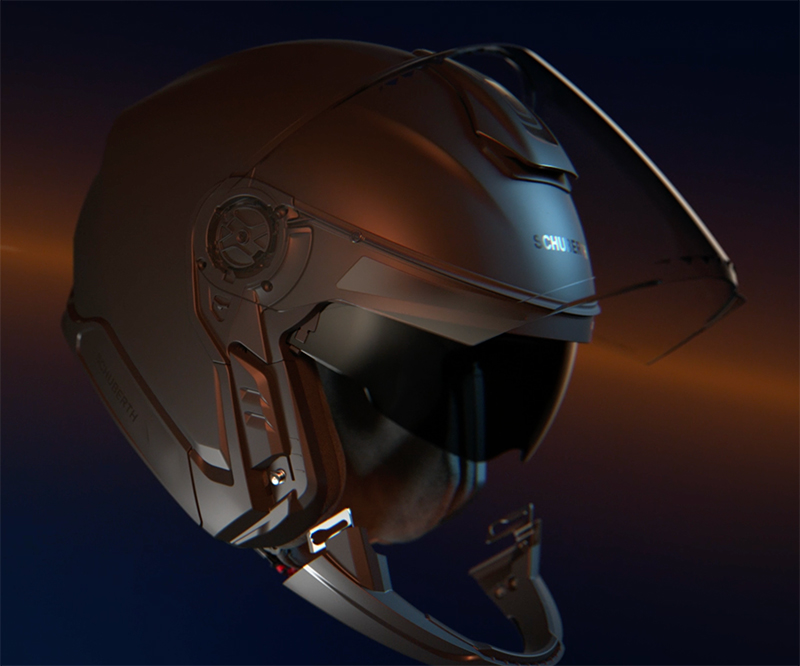
And that is a removable chin bar. Now I am not quite sure why you would ever want to ride without the chin bar; that's a personal choice I suppose. But the bar in no way impedes the view, or detracts from the helmet's ability to flow air. It's so discrete as to be almost invisible when the screen is lowered.
Yet if you do have an accident the chin bar will serve to provide a degree of protection to your chin and face.
But here's the thing. Schuberth tells us that in terms of its strength in the various ECE 22-06 tests the chin bar meets the standard that would allow it to be classified as a full-face helmet. But for one thing! The chin bar does not meet the minimum requirements in terms of height.
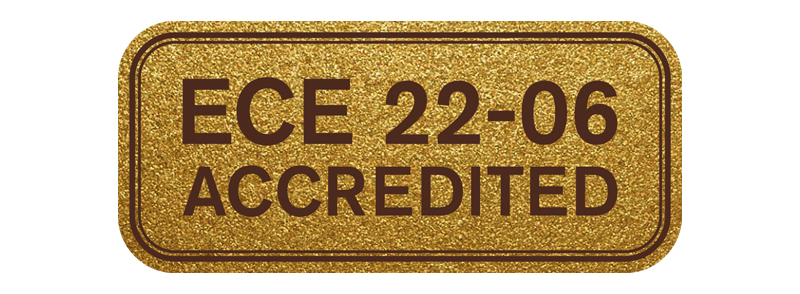
And that's a shame because it would have increased confidence in the J2 if Schuberth had been able to claim that it was both 'P' (full-face) and 'J' (open-face) rated. But as it is that's not the case. The J2 is accredited only as an open-face helmet.
In fact, on a technical level, it might be frowned upon for us to suggest that the J2 is any more protective than an open-face helmet. And that's because the authorities do not want manufacturers and retailers to make claims that cannot be justified. But given what Schuberth says about the strength of the chin bar, and we believe what they have told us, then it makes sense to suggest that the J2 is going to provide at least a degree of extra protection over a similar helmet without a chin bar. I cannot point to independent testing to prove this but, to us, it seems an almost undeniable truth.
What we don't know, and what we will never know, is whether Schuberth messed up and only realised that the helmet would not meet the full-face standard when it was too late to go back and start again. Or whether they took the view that a taller chin bar would have somehow changed the essence of the J2 as a cruiser helmet. We would like to think it was the latter, and certainly the only similar helmet on the market with a removable chin bar that we know of, the Nolan N44, does end up looking more like a full-face helmet than an open-face one.
Anyway, we will never know the answer to that question. So let's take a look at the J2 in a bit more depth.
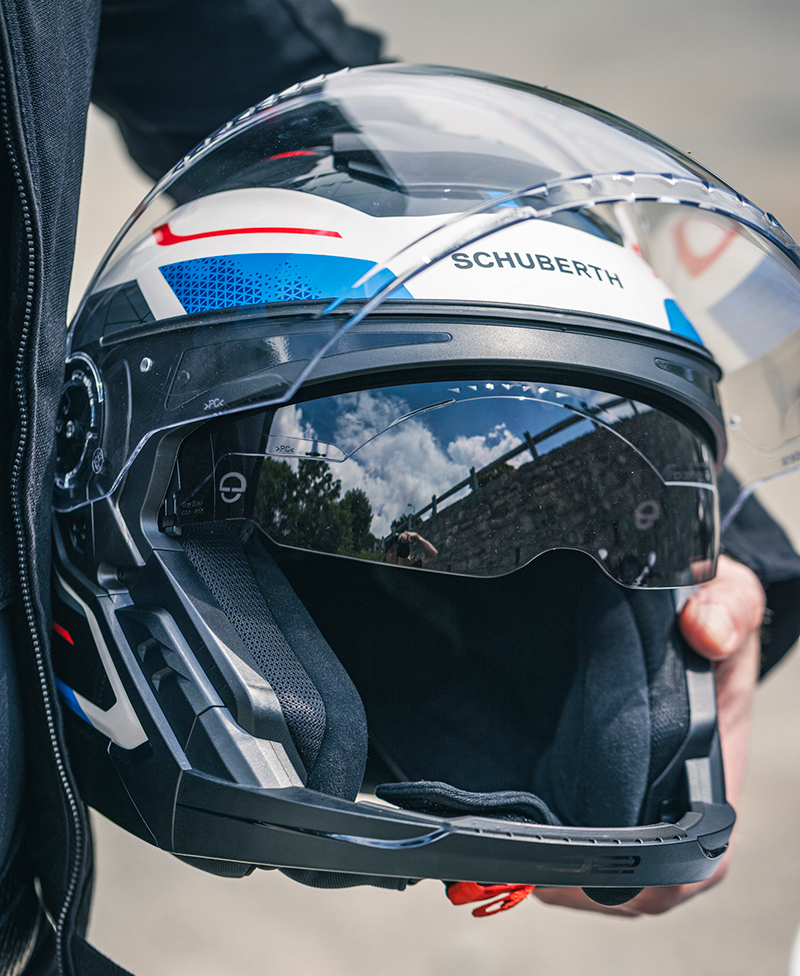
The Schuberth J2 helmet in detail
Schuberth tells us that this helmet has no single part in common with its predecessor; and that doesn’t perhaps surprise us, as the J1 had gone out of production before we even got in to the motorcycle business.
The J2 has the same type of shell that is used on all of Schuberth's ECE 22-06 helmets. It’s constructed using their patented Direct Fibre Processing Technology that sees carbon fibre being used to reinforce other organic fibres.

Schuberth talk about how this delivers a lightweight shell that achieves ‘remarkable’ shock absorption values. All we can say is that in size Large the J2 is 100g, heavier than the J-Cruise. Insofar as shock absorption is concerned, all we know is that the helmet passes 22-06, but Schuberth tells us no more than that.
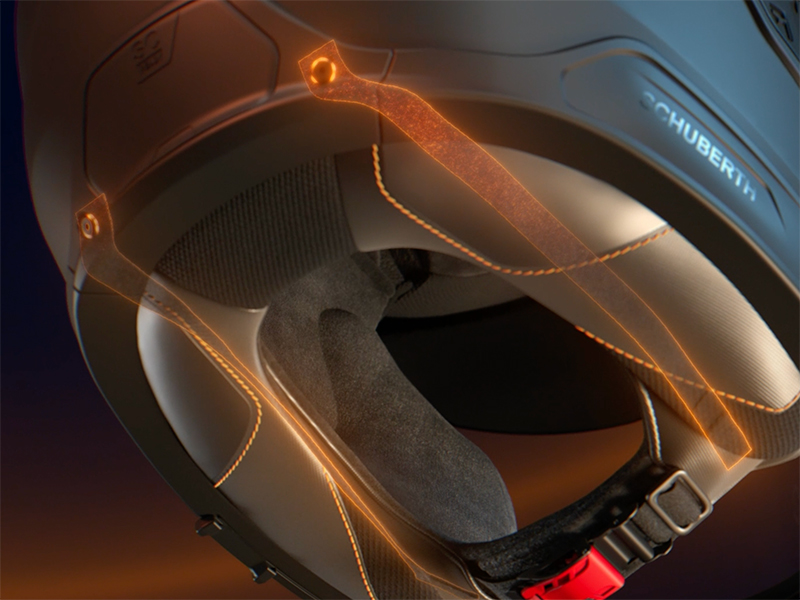
The helmet features the Anti-Roll-Off system (AROS) that has been a feature of all Schuberth helmets for many years. Intuitively, the system seems to make sense, and to add an additional element of reassurance that your helmet will never come off in an accident. But interestingly no other manufacturer, even those competing in MotoGP, has tried to emulate it. The only downside with the system is that it can sometimes impact on the adjustability of the chinstrap.
The chin bar we have discussed. Schuberth actually has no qualms about talking about this being an additional protective feature, so I suppose we cannot really be in trouble for suggesting the same, as long as you accept that the J2 is still going to provide less protection than a full-face helmet.
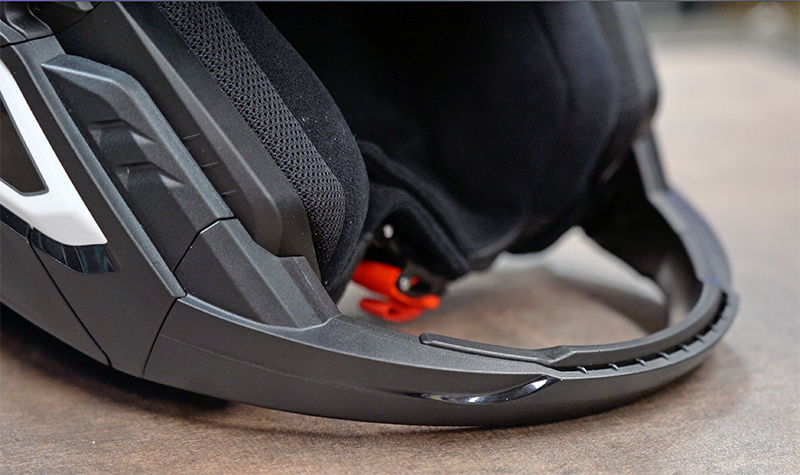
We really like the way the chin bar affixes to the helmet. It's easy to remove, and it really doesn't impair the view. I sold a J-Cruise to a lady recently because she reckoned it was the only helmet that allowed her to read the speedo on the tank of her Harley. In all honesty, I don't think the thin chin bar on the Schuberth would get in her way.
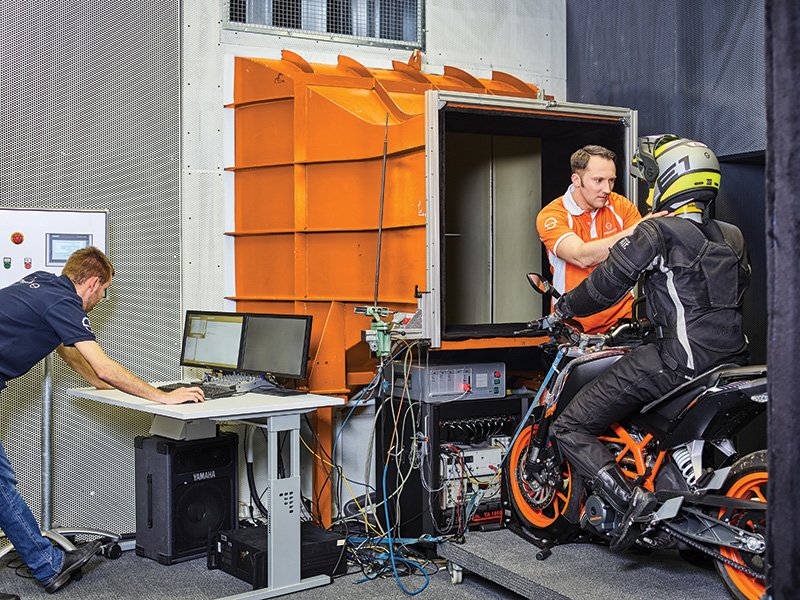
Let's talk noise
Now it is natural for a manufacturer to talk things up. And in their launch video the company's management was at pains to tell the world about how their wind tunnel testing had allowed them to achieve an 88db rating at 100 kph on a naked bike. They claim that this is quieter than any similar helmet on the market, although we slightly take the view that the Schuberth head form used for these tests might have a bearing on the matter.
Now here at Motolegends we make it clear to anybody wanting any kind of open-face helmet that they will have to accept higher noise levels, although we do accept that helmets with full-length visors might be quieter than pure jet helmets.
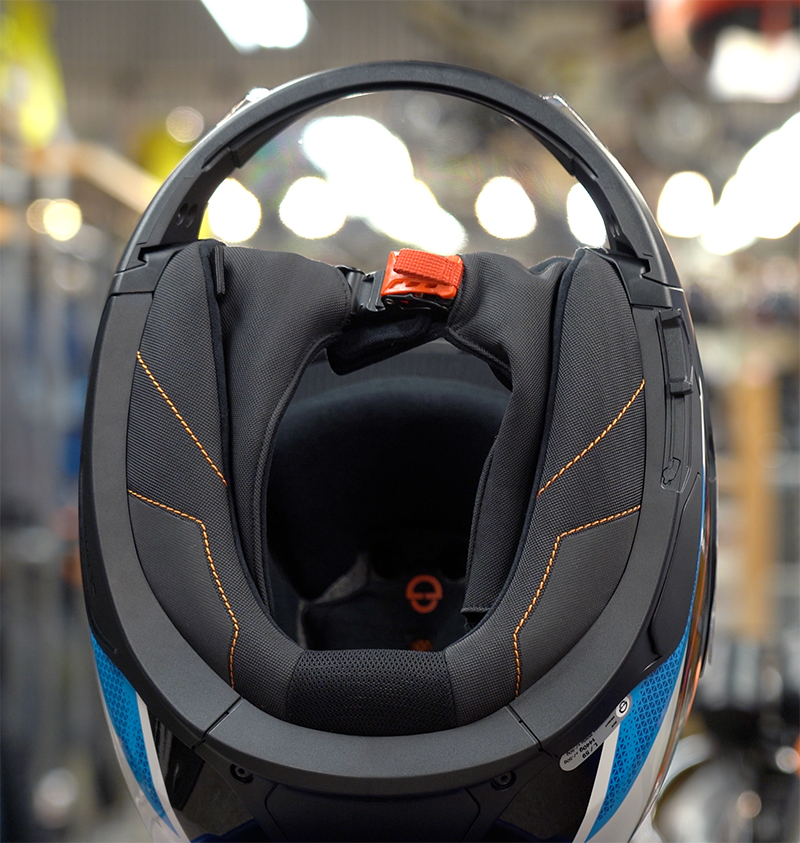
Schuberth has endowed the J2 with a tighter neck roll, as in the C5 and their other helmets. And this will help, but the very large space between the bottom edge of the visor and the cheek pads is the weak point. Air is going to enter the helmet here, and air at speed, when it reaches the ears, is noise!
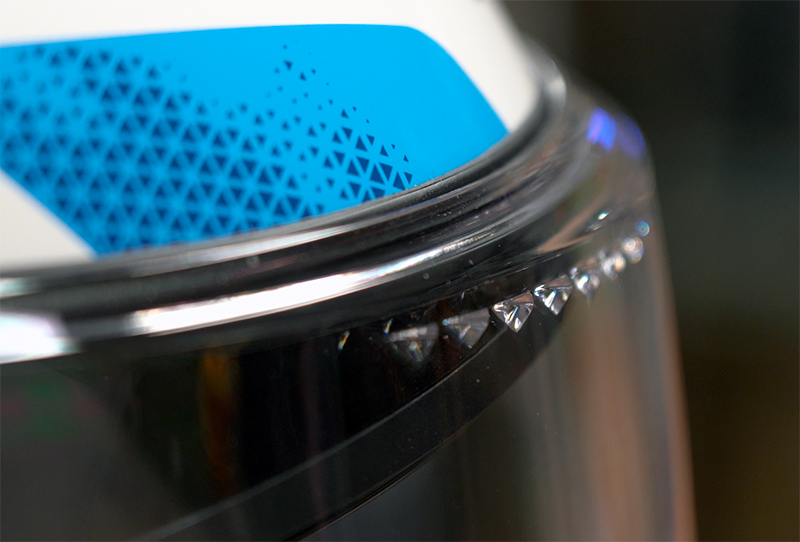
The company also talks about its ridged ‘Turbulators’ that run along the top of the visor. These are meant to reduce wind turbulence, and once again should serve to make the J2 quieter.
But we shouldn't get carried away. Schuberth has claimed the J2 is quieter than its competitors. And this might even be the case, but the J2 is still going to be a noisy helmet.
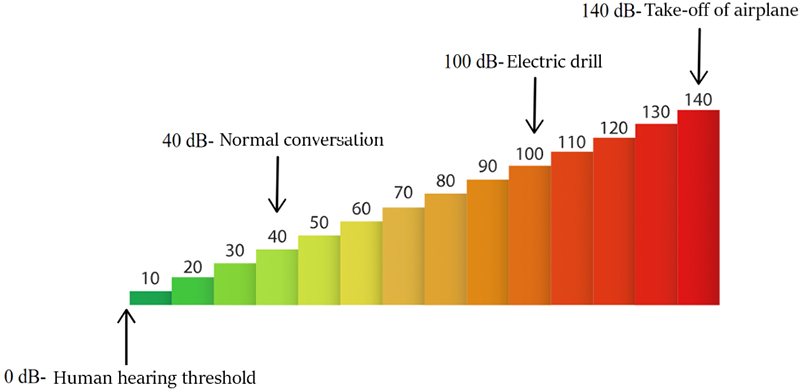
Let us compare Schuberth's 88 decibel rating for the J2 with the 85 decibels of the C5, for example. Now that increase does not sound like much, but decibels are measured using a logarithmic scale. So the three decibel increase actually indicates a doubling in the sound intensity, meaning that the safe 'exposure time' is halved.
It is suggested that exposure to sounds above 85 decibels can lead to hearing loss. At 85 decibels it is suggested that the safe exposure time is eight hours. At 88 decibels it comes down to four hours. In terms of understanding what this means, 85 decibels is equivalent to a noisy restaurant, a food blender, or a heavy truck. 88 decibels is what you'd experience driving a forklift truck.
We are not saying that Schuberth has not done a great job here. They probably have. But our job is to separate the wheat from the chaff. And whilst 88 decibels may be great for an open-face helmet, it still constitutes a noisy helmet. And certainly suggests that if you’re going for a J2 you should wear earplugs.
There is one thing that mitigates in favour of the J2. And that is that it will very often be worn by riders of cruiser-style bikes with large screens. And if that's the case then noise may indeed be less of an issue.
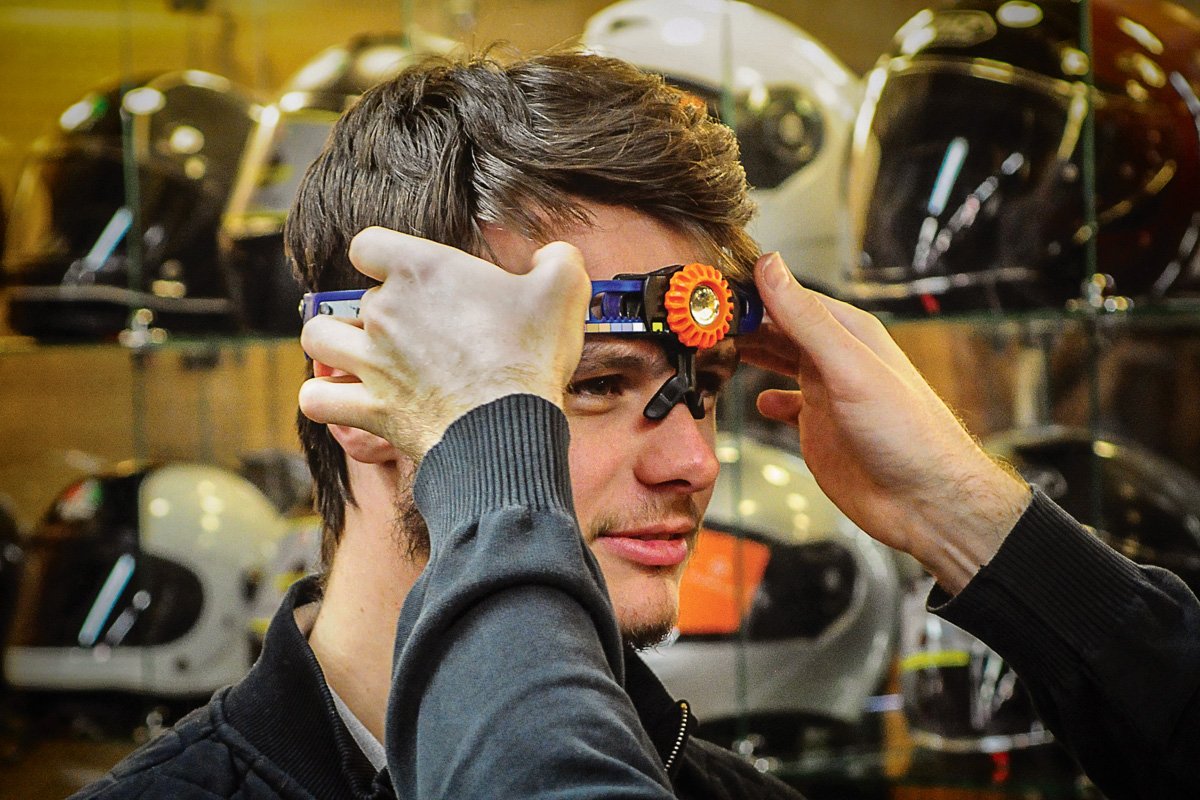
The fitting of the J2
It is widely accepted that the mark of a properly premium helmet brand is at least three shell sizes. That's what you get with every Shoei and with every Arai. With three shell sizes you have a better chance of getting a perfect fit, and you help avoid some of those instances where a helmet can look like an over-sized bowling ball on your head.
Like all Schuberths and all Sharks, the J2 only comes in two shell sizes.
In their launch video presentation, Schuberth proudly spoke about how they were able to get their Large size (58-59) into the smaller of their two shell sizes. Well, I have to say that this is exactly where we often have a problem when it comes to fitting somebody into a Schuberth helmet.
Not infrequently if somebody measures bang on 59 they will find a Schuberth Large a tad too tight, front to back. Put them into the Extra Large, and that helmet will be massively large. Rotatable like a kitchen pail. For this very reason, here in the shop, a lot of people end up going for a Shoei instead.
We figure that the issue here, obviously, is the two shell sizes. Schuberth aspires to being a truly premium brand, but this won’t be the case until they produce their helmets in three shell sizes.
Now don't misunderstand us, the J2 will fit a lot of people very well. All the inner surfaces feel plush, and if your head fits, the J2 will be a very comfortable helmet to ride in.
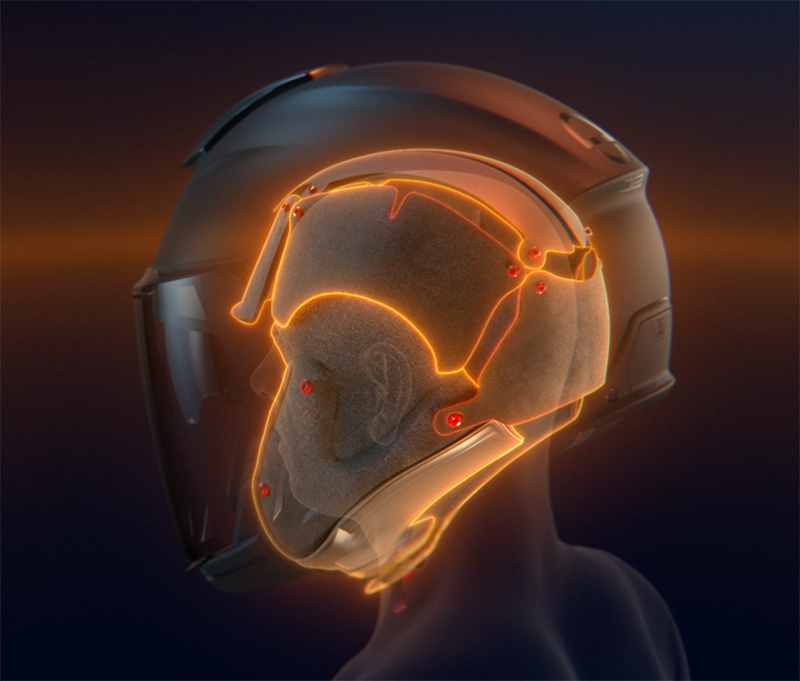
To increase the chances of getting the J2 to fit properly, we can use the same headliners and cheekpads that we can fit into the C5. Schuberth's system for custom fitting is not without its merits, as to an extent it allows the internal headshape to be adjusted; not just made smaller or larger. We can also use pads to raise or lower the height of the helmet.
But in our view Schuberth has not risen to the challenge of going head-to-head with Shoei. (See what I did there)? And that's because the Schuberth pads only work on three out of the six helmet sizes. That's Medium, Large and Extra Large. This will have been done because Schuberth knows that 80% of its sales come from the three main sizes. Yet it is disappointing. Especially to those who have really small, or really large, heads!
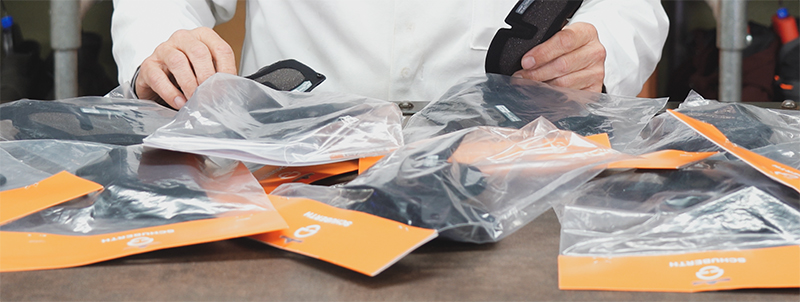
The other issue is the cost of these pads. On a Shoei or an Arai helmet there's an exchange scheme, so the customer pays nothing. But Schuberth expects you to pay £37 for a pack of side of head pads; and often you will need to split open two packs to get a good fit.
Personally, we don't like the idea of charging a customer extra to get an expensive helmet to fit properly. So if you visit us in the shop here in Guildford to buy your J2 we won't charge for the fitting of additional pads. And that could save you almost £75.
Now the cheekpads are also interchangeable, but here there's another issue. Because this is an open-face helmet the J2 comes with extra thick 32 mm. cheekpads. The other cheekpads that Schuberth offers are all 25 mm and below, so whilst it's not impossible the chances are that very few people will want to change to the thinner pads. And that’s because very rarely will you want the helmet to fit looser.
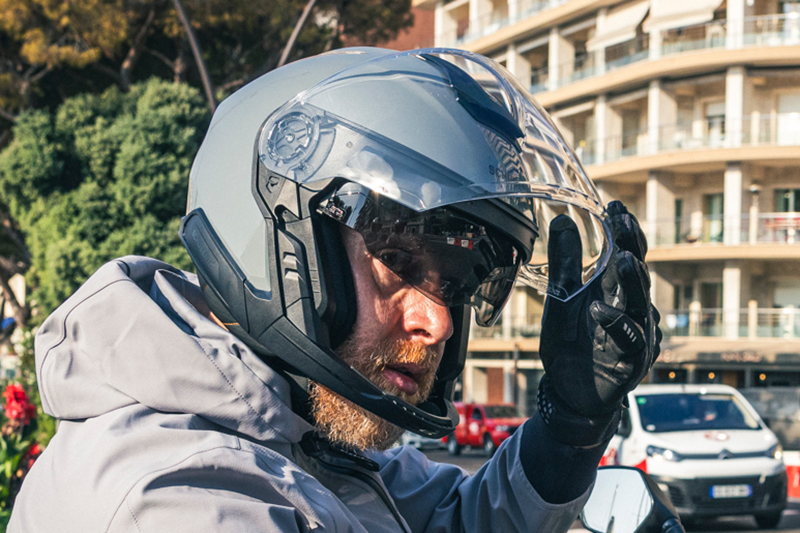
Other details
What else is there that you need to know?
Now Schuberth's visors are normally Class 1 optical quality. In the case of the J2 Schuberth says nothing about this.
What you don’t get as standard with the J2 is a Pinlock visor, but that’s because you are very rarely going to need one in a helmet where the oncoming air can so easily reduce the temperature behind the visor. All you have to do is incline your head backwards for half a second, and any misting will clear.
The visor is very easy to remove and replace.
You also, of course, get the same drop-down sun visor that you get in all Schuberths.
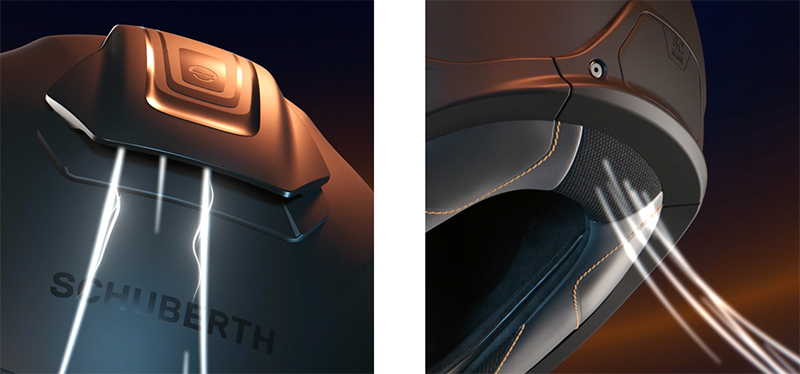
There’s a large, two-position vent on the brow. Obviously, there’s no requirement for a chin vent. The brow vent sends air running through the eps to to help cool the head. This air then exits the helmet through the back of the neck roll.

The neck strap is adjustable by means of a micrometric strap. The strap is adjustable from both sides.
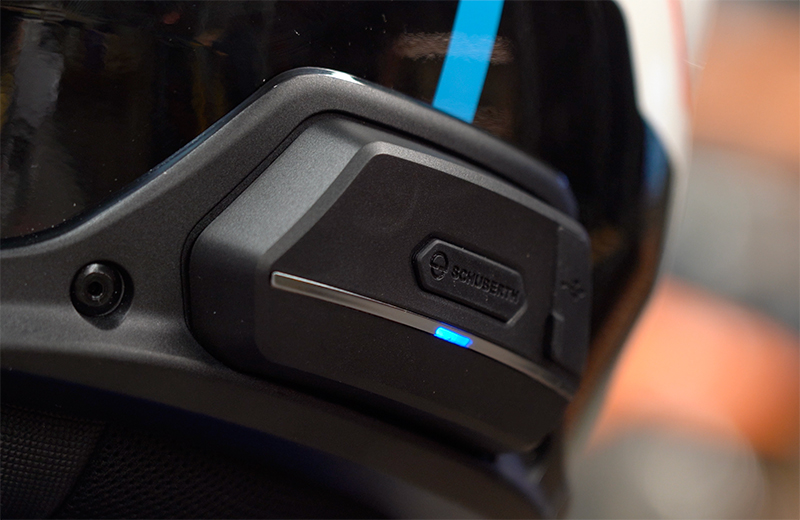
Comms. For the J2
We’re jumping the gun here, but let’s tell you what comms. units are available right now, and what should be coming along soon.
The unit that is available now is called the SC2. It’s based on the Sena 50S, and like all of Schuberth’s comms. systems it’s about as ‘Plug n Play’ as it gets. By which we mean that all the wiring, and the HD speakers, are pre-installed. You do need to connect up one wire at the back of the helmet, but it’s pretty straightforward. It’s a Mesh and Bluetooth system, but at £339.99 it’s expensive for those who want to talk with just one other bike or a pillion, and for those who only want to access the phone, the satnav and music. Although you will, of course, save the 20% VAT on this if you buy the comms. at the same time as you buy the helmet.

Due in the second quarter of 2025 is a cheaper version of the SC2 based on Sena’s 10S system. It’s called the SC2 Standard. It’s Bluetooth only. For those not looking to talk with an entire football team whilst on the move, this might be the more sensible option. The price is £239.99. Again, you can save the 20% VAT on this.
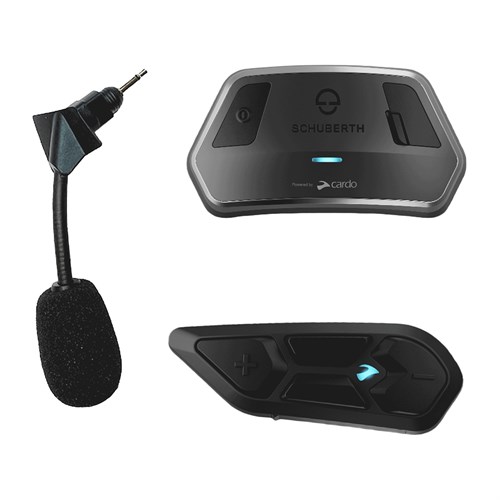
But for many the most exciting news is that Schuberth will soon be coming out with a unit that affixes directly into the helmet in exactly the same way, but that is powered by Cardo. This will be welcome by all those riders who swear by Cardo. The unit is based on Cardo’s top-of-the-line Packtalk Edge system, which offers both Mesh and Bluetooth communications. The price is the same £339.99 as the SC2 unit.
And so you are going to have to work out which system will work best for you. For a lot of people the new Standard system will be more than enough, but with the more expensive systems you are potentially engaging in a bit of ‘future proofing’. Either way, you are going to have to decide whether you’ll be riding with Sena people or with Cardo people, although with Schuberth you can at least now change the units if you ride with different groups.
But whatever you’ve read on the internet Cardo will not talk to Sena, unless you’re a complet anorak who spends most of his time in the shed talking with other like-minded individuals. What you can do now, though, is use the ‘Wave’ app. which allows anybody to talk to anybody.
You could probably mount a unit onto the side of the helmet, but it would be a helluva job, and the end result would be messy, I fear. You will also make the helmet noisier if you stick something carbuncle-like onto the shell.
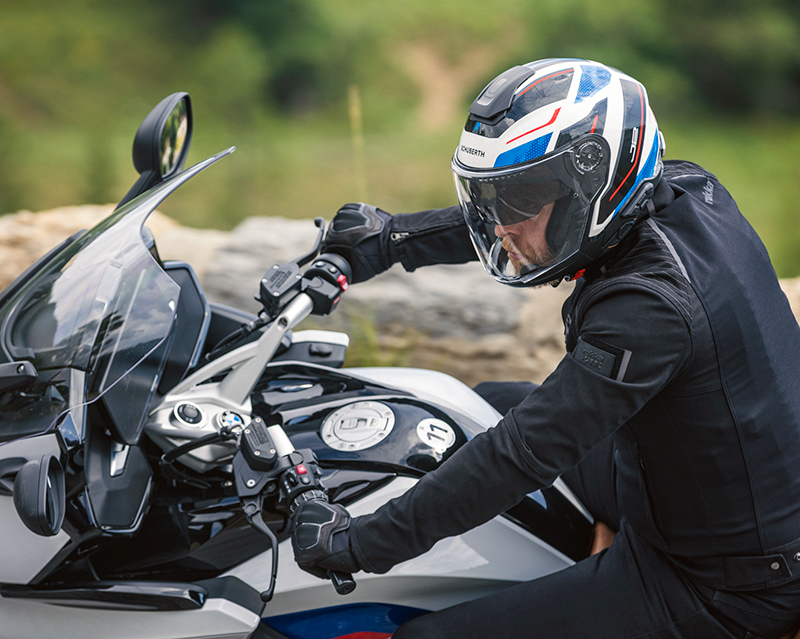
In summary
Inevitably, somebody from Schuberth will contact us to tell us that we have been unfair about their latest helmet. Well, we don’t think we have been; but we do like to drill down a little in order to fight through the hyperbole, the technical mumbo jumbo and those claims that, whilst not incorrect, could be deemed misleading. All manufacturers talk their gear up; understandably so, of course. But we like to bring it all down to terra firma.
Nonetheless, we like the J2. We think it’s a great helmet. And whether or not the chin bar meets the full demands of a full-face helmet under ECE 22-06, we have to say that the J2 has surely got to be safer to ride in than any of the other cruiser helmets out there.
The helmet is well built, and being based on the now-proven C5, we can say that everything should work the way it’s meant to; and bits shouldn’t fall off.
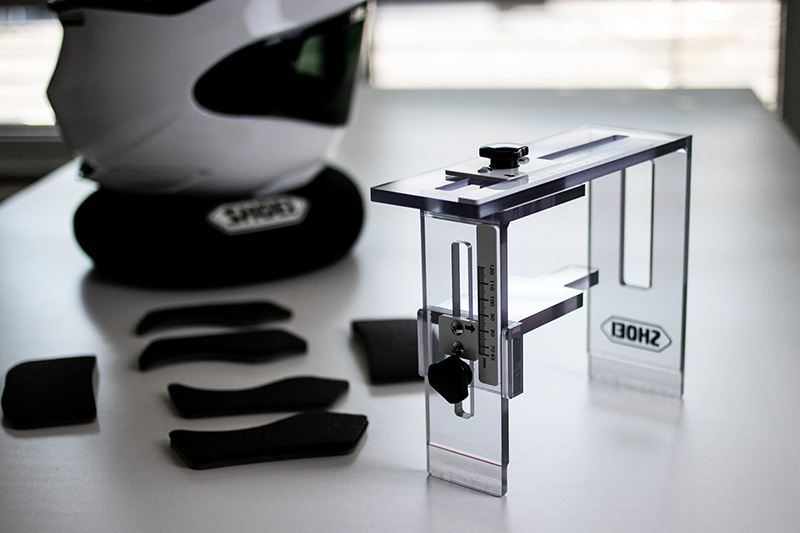
The two shell sizes will impact on comfort and fit. And the C5 gets left in the wake of the Shoei J-Cruise when one takes into account the Japanese company’s Personal Fitting System.
When it comes to comms., the German maker has stolen a march on Shoei, and many will be delighted that there’s now a Cardo system that will fit in all of Schuberth’s helmets.
Finally, let’s touch on costs because the J2 is not cheap. And certainly not if you look at it as just a regular, open-face helmet.
What Schuberth has managed to do, however, is undercut the Shoei J-Cruise to a point where there is a reasonable amount of clear blue water between them. The Shoei equivalent, be it a plain colour or a graphic, is consistently at least £120 more expensive. In many ways we would contend that the Shoei is made to a higher standard. But one cannot ignore the fact that in an accident the J2 will offer more protection than the J-Cruise. And who can say how much that is worth?
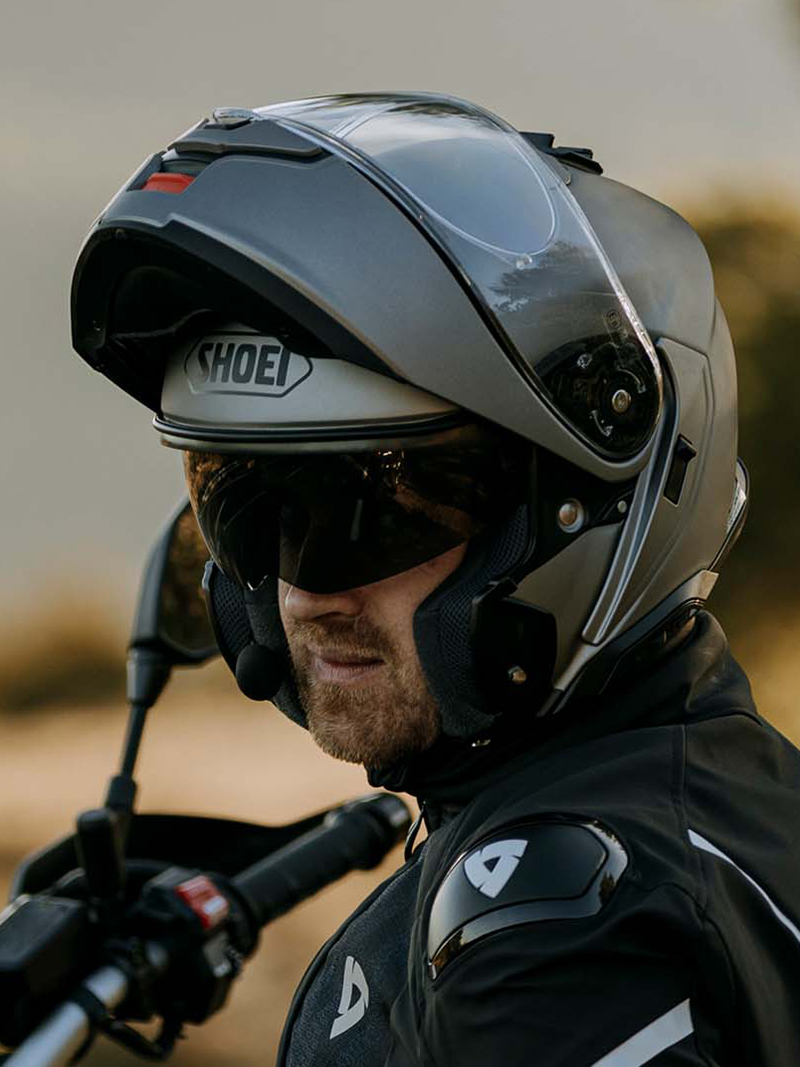
From my perspective, but I am horribly biased, I would always come back to whether most people would be better served by a flip like Schuberth’s own C5, or by Shoei’s Neotec.
For an extra £120-ish you will have a helmet that’s more protective. A helmet that can still allow you to get a lot of air on to your face. And a helmet that, on a longer journey, is going to do much less damage to your ears.
But that is to ignore considerations of style and looks. And some people just like the way helmets like the J2 look. In the same way that some people just don’t like flip lids. Some like the field of vision you get from a helmet like the J2. And some like the air flow that is generated by such helmets.
And all these things, I suppose, we can understand.
One last thing, Schuberth is very poor at delivering stock, and if, especially in the early days after release, some colours and designs are not available that’s usually down to Schuberth, and not us or the importer. We just thought you should know.
You can buy a Schuberth J2 helmet with free next day UK delivery online, or visit our store in Guildford to try one on.
Share this story































































